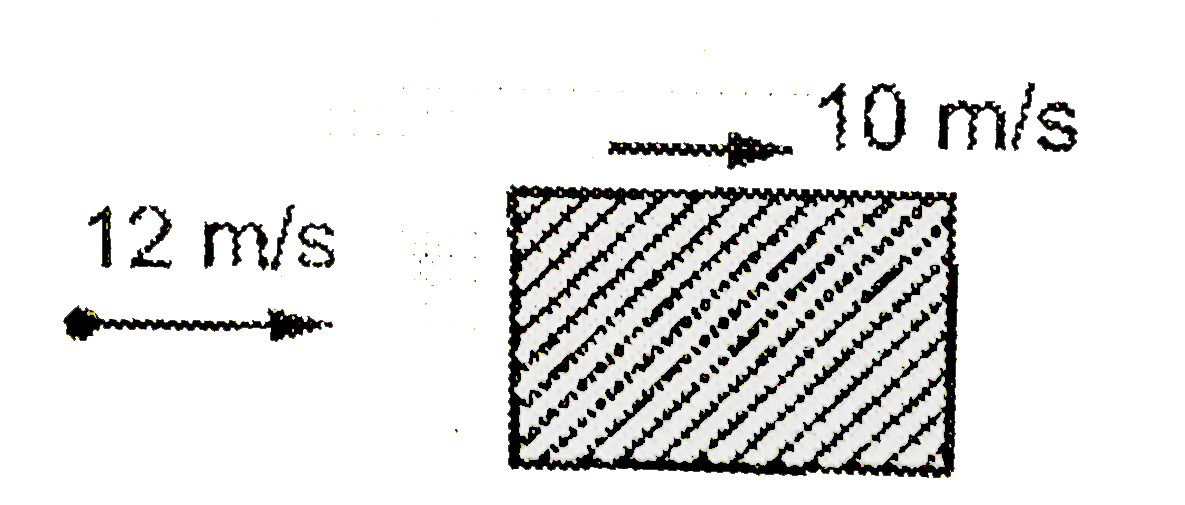Statement 1 : Two particles moving in the same direction do not lose all their energy in a completely inelastic collision.
Statement 2 : The principle of conservation of momentum holds true for all kinds of collisions.
If both assertion and reason are corret and reason is a correct explanation of the assertion .
If both assertion and reason are correct but reason is ot the correct explanation of assertion .
If assertion is correct but reason is incorrect .
If both assertion and reason are incorrect .
The correct Answer is:A
When two bodies are moving in the same direction then there is net linear momentum of the system in the same direction, hence there must be same linear momentum in the system after the collision also . We can understand that assertion is true ans reason is also true . Moreover , reason forms the basis to explain assertion. Ratio of the intial kinetic energy to taht with the final kinetic energy can be written as follows :
K1K2=12mu214mu2=2
Topper's Solved these Questions
- WORK, ENERGY AND POWER BOOK - MODERN PUBLICATIONCHAPTER - WORK, ENERGY AND POWER EXERCISE - Objective Type Questions (Matrix Match Type Questions)
2 Videos
- WORK, ENERGY AND POWER BOOK - MODERN PUBLICATIONCHAPTER - WORK, ENERGY AND POWER EXERCISE - Objective Type Questions (Integer Type Questions)
7 Videos
- WORK, ENERGY AND POWER BOOK - MODERN PUBLICATIONCHAPTER - WORK, ENERGY AND POWER EXERCISE - Objective Type Questions (D. Multiple Choice Questions)
10 Videos
- WAVESBOOK - MODERN PUBLICATIONCHAPTER - WAVESEXERCISE - CHAPTER PRACTICE TEST
14 Videos
Similar Questions
Two particles each of mass m moving with equal speed 2m/s along the indicated direction in the figure undergo a perfectly inelastic collision.Velocity of combined system after collision is ?
View SolutionStatement 1: Two particle have same linear momentum, wavelength of both particle will be same
Statement 2: If wavelength of particle increase then energy and linear momentum also increases
View Solution
Knowledge Check
Statement-1 : Kinetic energy is conserved in both, perfectly elastic and perfectly inelastic collisions.
Statement-2 : Because linear momentum is conserved in both.AStatement - 1 is ture , statement -2 is true, and statement-2 is correct explanation of statement -1.BStatement-1 if ture, statement-2 is true, but statement -2 is not a correct explanation of statement-1.CStatement-1 is true, but statement -2 is false.DStatement-1 is false, but statement-2 is true.A light particle moving horizontally with a speed of 12m/s strikes a very heavy block moving in the same direction at 10m/s. The collision is one-dimensional and elastic. After the collision, the particle will
 Amove at 12m/s opposite to its original directionBmove at 8m/s in its original directionCmove at 8m/s opposite to its original directionDmove at 2m/s in its original direction
Amove at 12m/s opposite to its original directionBmove at 8m/s in its original directionCmove at 8m/s opposite to its original directionDmove at 2m/s in its original directionAssertion:The principal of conservation of energy is valid for inelastic collision.
Reason: The principal of conservation of energy holds good in both elastic and inelastic collision. In case of inelastic collision kinetic energy before and after collision is not same.AIf both assertion and reason are true and reason is the correct explanation of assertion.BIf both assertion and reason are true but reason is not the correct explanation of assertion.CIf assertion is true but reason is false.DIf assertion and reason are false.
Which of the following statements is false for collisions-
(1)Momentum is conserved in elastic collisions but not in inelastic collisions.
(2)Total-kinetic energy is conserved in elastic collisions but momentum is not conserved.
(3)Total kinetic energy and momentum both are conserved in all types of collisions
(4)Total kinetic energy is not conserved in inelastic collisions but momentum is conserved
View SolutionStatement-1: kinetic energy of SHM at mean position is equal to potential energy at ends for a particle moving in SHM.
Statement-2: Total energy in SHM is conserved.
View SolutionTwo identical vehicles are moving with same velocity v towards an intersection as shown in figure. If the collision is completely inelastic, then

View SolutionTwo particles moving initially in the same direction undergo a one- dimensional , elastic collision . Their relative velocities before and after the collision are →v1 and →v2. Which of the following is not correct?
View SolutionAssertion: Linear momentum is conserved in both elastic and inelastic collisions.
Reason: Total energy is conserved in all collisions.
View Solution
